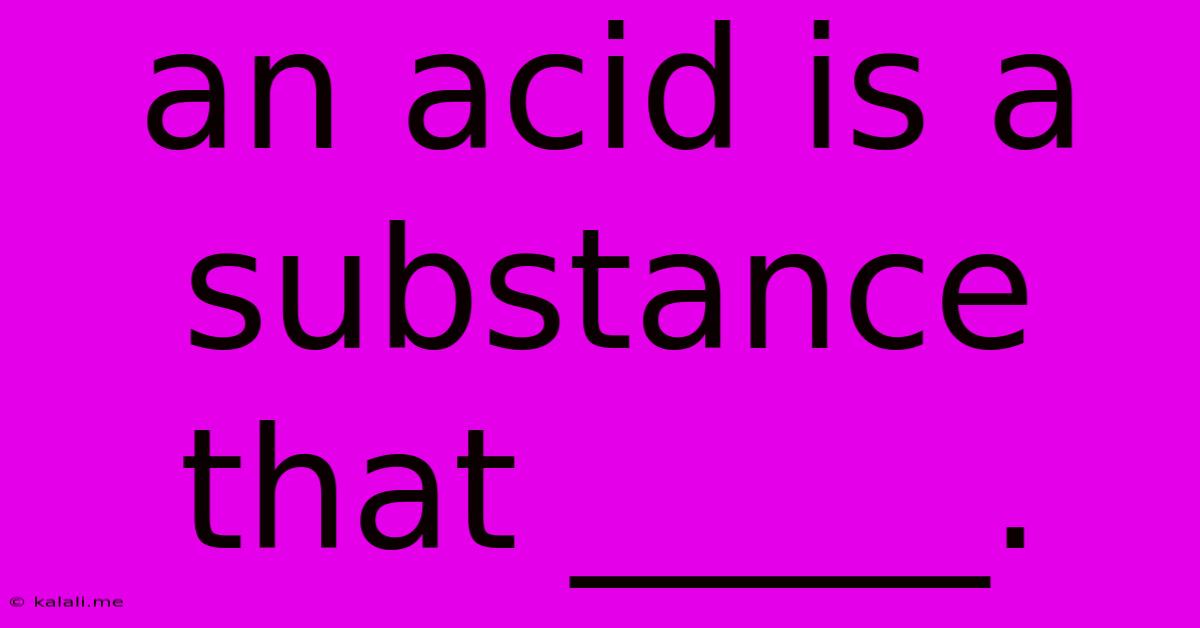An Acid Is A Substance That _____.
Kalali
Jun 15, 2025 · 3 min read

Table of Contents
An Acid is a Substance That... Donates Protons! Understanding Acid-Base Chemistry
Meta Description: Dive into the fundamental definition of an acid: a substance that donates protons. We'll explore this key characteristic, examining different acid types and their properties with clear explanations and examples.
An acid is a substance that donates protons (H⁺). This seemingly simple definition opens the door to a fascinating world of chemistry, impacting everything from the acidity of your stomach to the production of fertilizers. But what exactly does it mean to "donate a proton"? And how does this definition help us understand the behavior of acids? Let's delve deeper.
The Brønsted-Lowry Definition: The Heart of Acidity
The statement "an acid is a substance that donates protons" is rooted in the Brønsted-Lowry acid-base theory. This theory provides a more comprehensive understanding of acids and bases than earlier definitions. It defines an acid as a proton donor and a base as a proton acceptor. A proton, in this context, refers to a hydrogen ion (H⁺), essentially a hydrogen atom that has lost its electron.
This definition allows us to understand acid-base reactions as proton transfer processes. When an acid reacts with a base, the acid donates a proton to the base. This transfer results in the formation of a conjugate base (from the acid) and a conjugate acid (from the base).
Types of Acids: A Diverse Family
Acids come in various forms, each exhibiting unique properties:
-
Strong Acids: These readily and completely donate their protons in aqueous solutions. Examples include hydrochloric acid (HCl), sulfuric acid (H₂SO₄), and nitric acid (HNO₃). Their complete dissociation leads to a high concentration of H⁺ ions, resulting in a lower pH.
-
Weak Acids: These only partially donate their protons in aqueous solutions. Acetic acid (CH₃COOH), found in vinegar, and carbonic acid (H₂CO₃), present in carbonated drinks, are common examples. Their incomplete dissociation results in a lower concentration of H⁺ ions and a higher pH compared to strong acids.
-
Monoprotic, Diprotic, and Polyprotic Acids: The number of protons an acid can donate determines its classification. Monoprotic acids, like HCl, donate one proton. Diprotic acids, like H₂SO₄, donate two protons, and polyprotic acids donate more than two.
Understanding pH and Acid Strength
The concentration of hydrogen ions (H⁺) in a solution determines its pH. A lower pH indicates a higher concentration of H⁺ ions and therefore a stronger acidic solution. The pH scale ranges from 0 to 14, with 7 being neutral. Solutions with a pH less than 7 are acidic, while those with a pH greater than 7 are basic (alkaline).
Acid strength is directly related to the ease with which an acid donates its proton. Strong acids readily donate their protons, resulting in a low pH, while weak acids donate protons less readily, resulting in a higher pH.
The Importance of Acids in Everyday Life
Acids are ubiquitous in our daily lives. They play vital roles in numerous processes, including:
- Digestion: Hydrochloric acid in the stomach aids in the breakdown of food.
- Industrial Processes: Acids are crucial in manufacturing various products, including fertilizers, plastics, and pharmaceuticals.
- Food Preservation: Certain acids act as preservatives, inhibiting bacterial growth.
Understanding the fundamental definition of an acid—a substance that donates protons—is crucial to grasp its role in various chemical reactions and its widespread importance in our world. The Brønsted-Lowry theory provides a robust framework for comprehending the behavior of acids and bases, enabling us to predict and understand their interactions in a variety of contexts.
Latest Posts
Latest Posts
-
What Is 80 Percent Of 100
Jun 16, 2025
-
Pulmonary Ventilation Is More Commonly Called
Jun 16, 2025
-
What Are The Prime Factorization Of 58
Jun 16, 2025
-
Which Of The Following Is A Multiple Of 4
Jun 16, 2025
-
What Is The Value Of 1 4
Jun 16, 2025
Related Post
Thank you for visiting our website which covers about An Acid Is A Substance That _____. . We hope the information provided has been useful to you. Feel free to contact us if you have any questions or need further assistance. See you next time and don't miss to bookmark.